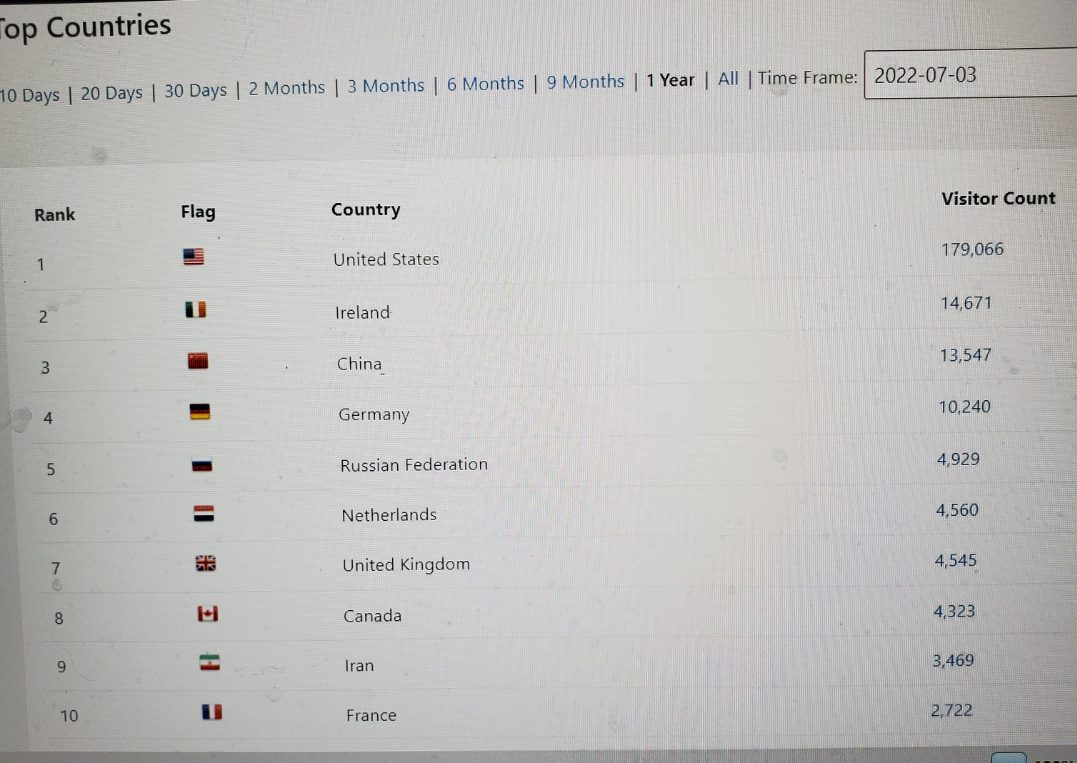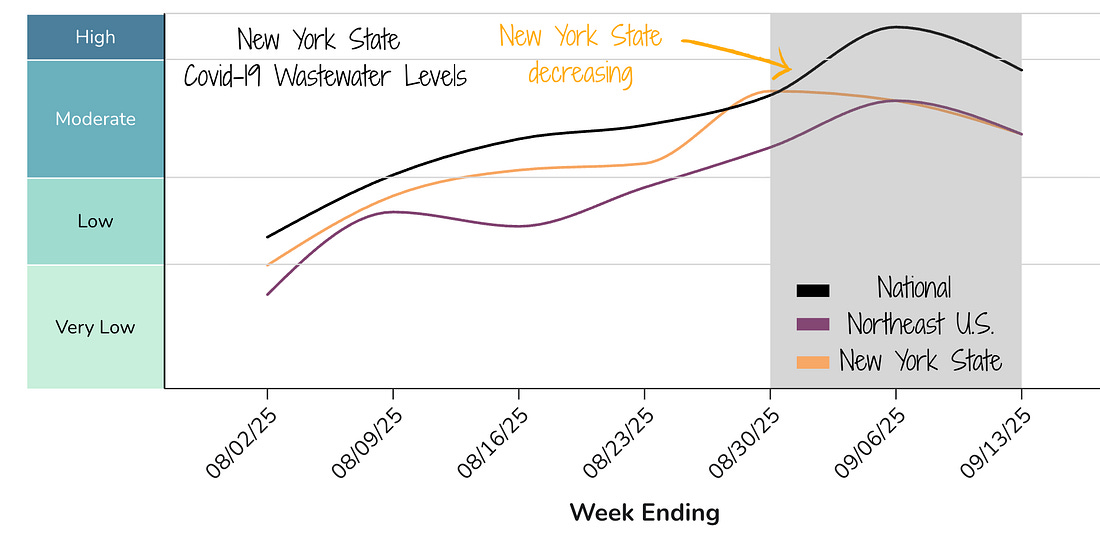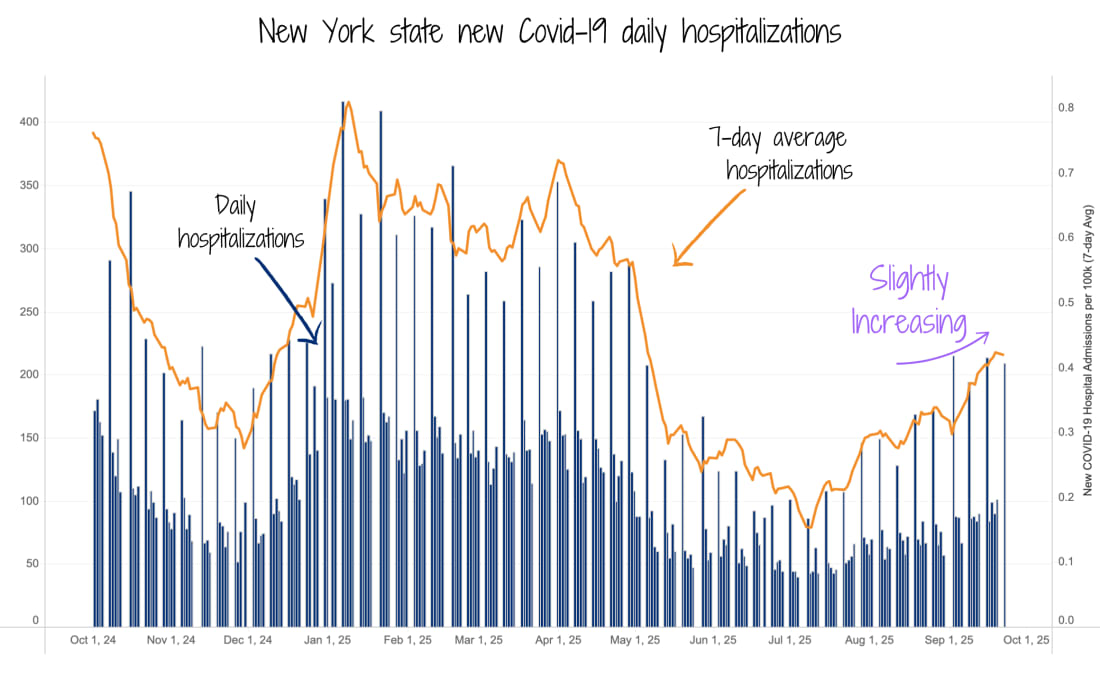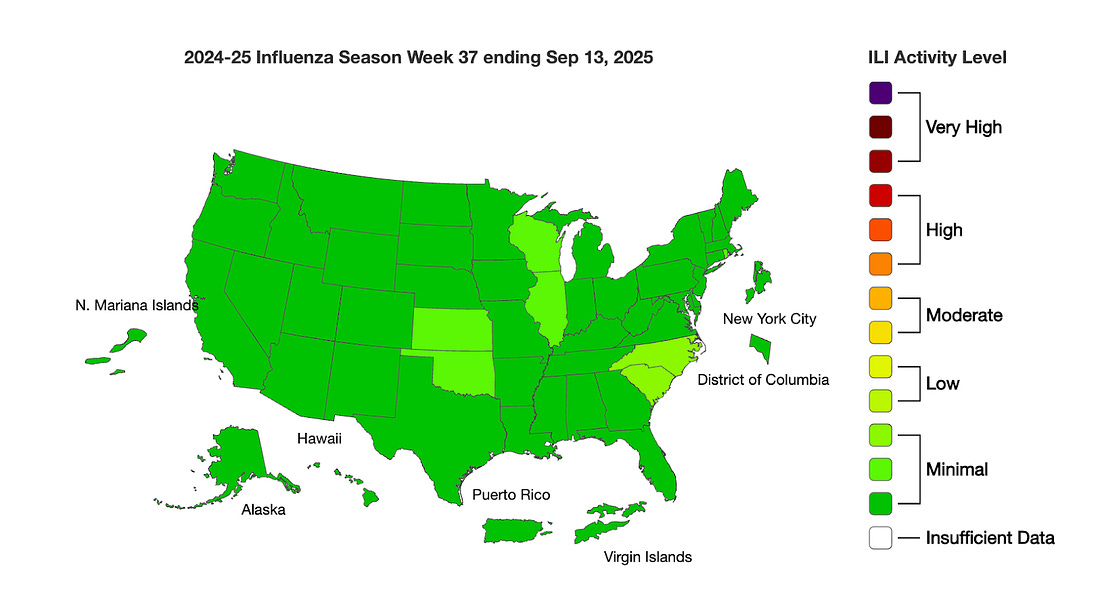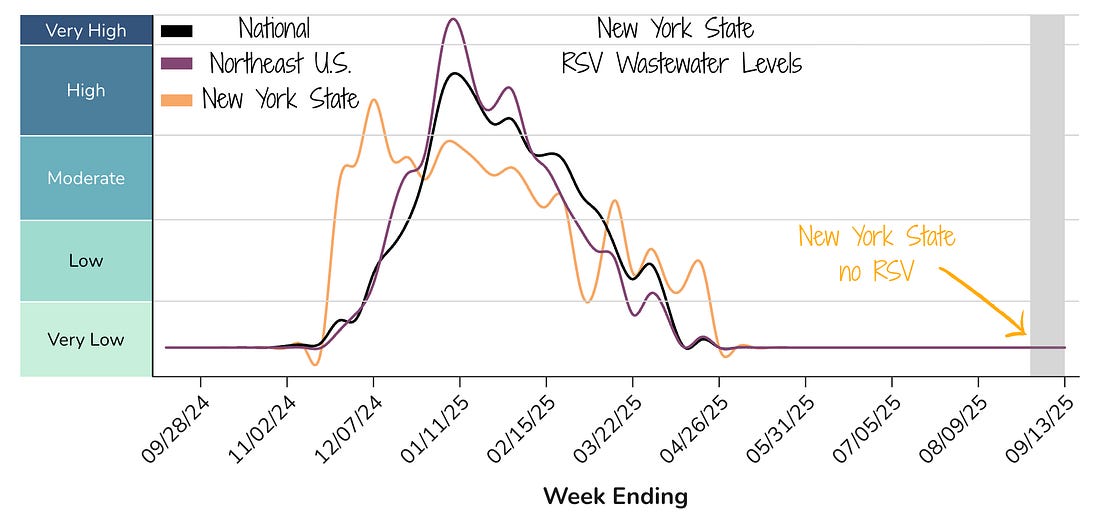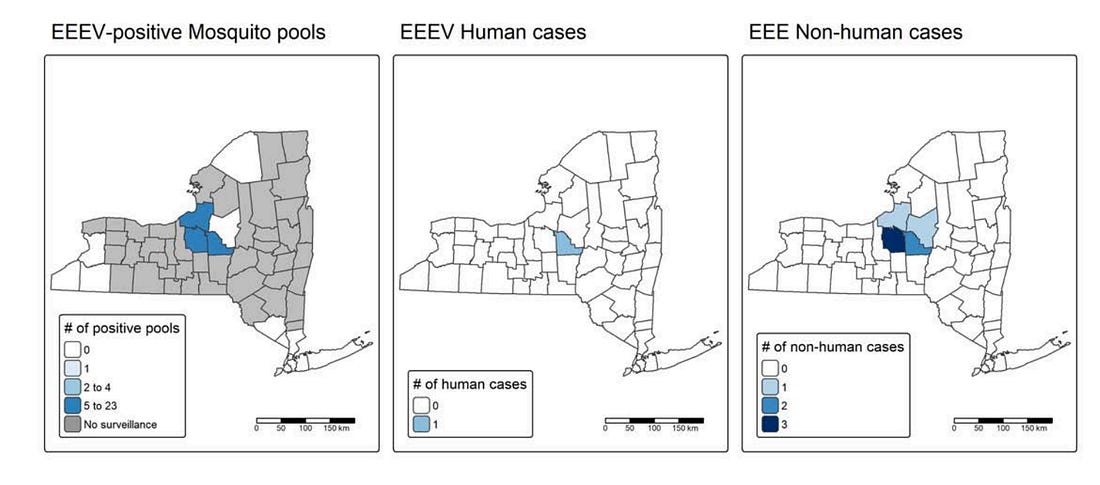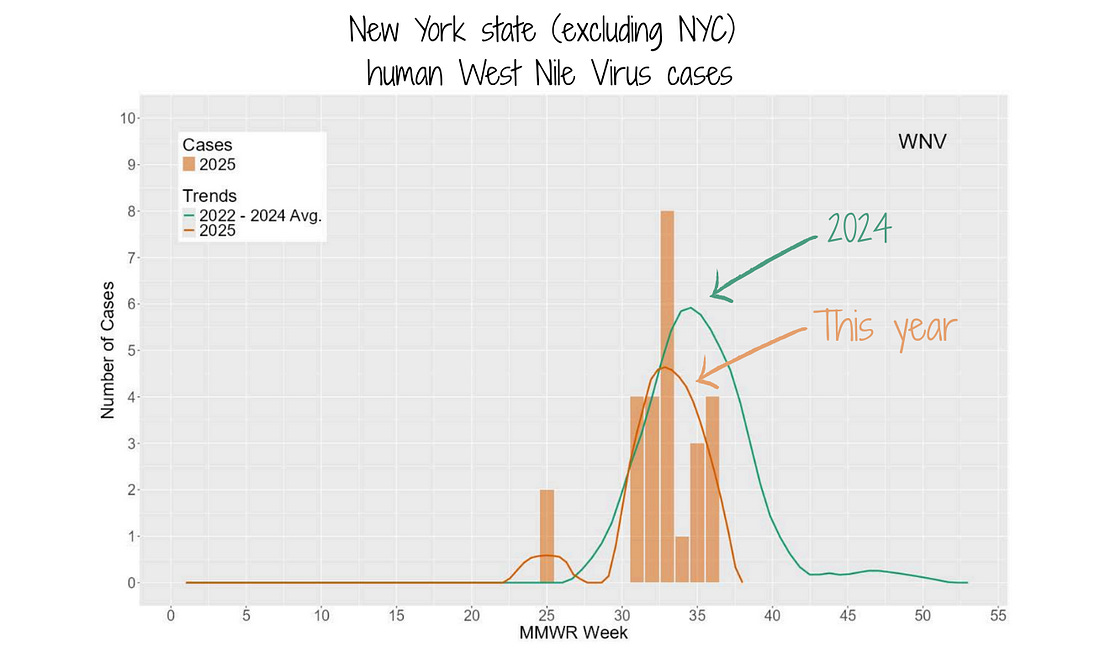Hits: 134
Enjoying this newsletter? Why not share it with a friend? Covid finally declining, EEE in Madison County, confusion around autism and Tylenol, and moreThe NY Dose
It’s been a whirlwind week in public health. From shifting Covid-19 vaccine recommendations and a debate over Tylenol and autism, to declining Covid levels in New York and even a case of eastern equine encephalitis, there’s a lot to sort through. Here’s what you need to know this week. Infectious disease “weather report”Covid is past its peak in New YorkForecast: Moderate and declining as measured by wastewater data, signaling that we’ve made it through the worst of the summer surge.
New York state Covid-19 wastewater activity levels. Figure from CDC NWSS. Annotations by YLE. Covid hospitalizations are still elevated. Because wastewater is a leading indicator and has just started decreasing, we can expect hospitalizations to follow and begin decreasing in the next week or two.
New York state Covid-19 hospitalizations. Figure from the New York State Department of Health. Annotations by YLE. The fluForecast: No activity in New York yet. All states, including New York, are at the minimal influenza-like illness (ILI) level, and New York wastewater shows no flu activity.
Figure from the CDC. I’m planning on getting my flu shot this week before I travel out of the county in early October. RSVForecast: No activity in New York yet. Wastewater and hospitalizations still show no RSV activity in New York.
New York state RSV wastewater activity levels. Figure from CDC NWSS. Annotations by YLE. Nationally, we moved from 0 hospitalizations per 100k to 0.1, which could be a very early sign that the season is starting or about to start. Mosquito-transmitted virusesHuman infection of eastern equine encephalitis virus in Central New YorkLast week a resident of Madison County was hospitalized with eastern equine encephalitis (EEE), a virus transmitted by some species of mosquitoes. This is the county’s first ever human EEE infection. EEE is rare in New York and the rest of the U.S.—last year, New York had its first human case since 2015 in a resident of Ulster County, who sadly died. Most people infected with EEE won’t have any symptoms. But for those who develop symptoms, the illness can be severe and involve inflammation of the brain (encephalitis) and spinal cord (meningitis).
EEE is rare in New York, but is more concentrated in Central New York this year. Since 1971, only 13 human cases have been identified in the state, including the most recent one. Of these patients, seven died. By this time last year, 14 counties across the state detected EEE in mosquitoes, mammals, or birds. So far this year, EEE has only been detected in 4 counties: Madison, Onondaga, Oswego, and Oneida.
Easter equine encephalitis virus (EEE) detections in mosquitoes, humans, and animals. Figure from the NY DOH. But more mosquitoes have tested positive so far this year compared to last. Even though there are fewer counties detecting EEE, the detections are more concentrated in a smaller area—there’s a hotspot in Central New York. Prevention of EEE is the same as for West Nile virus: it’s focused on reducing the mosquito populations and avoiding insect bites. West Nile virus is active across New YorkThe most recent data show mosquitoes tested positive in:
So far, the number of human infections seen this year is comparable to the average of the previous three years.
New York West Nile Virus infections for this year (2025) and the average of the previous 3 years (green). Data from NY DOH. Annotations by YLE. What this means for you:
Follow-up on ACIP meeting updatesI tuned into last week’s Advisory Committee on Immunization Practices (ACIP) meeting—and it was messy. Members openly said they weren’t sure what they were voting on, some votes had to be redone or skipped, and there was repeated confusion over whether certain issues even fell within ACIP’s jurisdiction. That said, the outcome was more patient-friendly than many expected. Katelyn covered the details in a recent YLE National piece here. Here are the high-level outcomes: Covid vaccines: ACIP shifted Covid vaccine recommendations to shared clinical decision-making for everyone aged 6 months and older. That means that the decision to vaccinate now falls to conversations between patients (or parents) and clinicians—whether your primary care provider, specialist, or pharmacist.
Figure from YLE National. Depending on what state you live in, though, you may still need a prescription. ACIP’s guidance is now more broad than FDA’s: FDA continues to classify the Covid vaccine as “off-label” for some groups (like healthy adults and children without underlying conditions). In some states, this ACIP/CDC vs. FDA mismatch could mean patients need a prescription to access the vaccine. In New York, this discrepancy will not disrupt vaccine access. Governor Hochul earlier issued an Executive Order that allows pharmacists to both prescribe and administer Covid-19 vaccines for people aged 3 and older without a patient-specific prescription. That law means that even under the new federal guidance emphasizing shared decision-making, folks in New York should still be able to get vaccinated conveniently, including via pharmacies. What this means for New York: The Executive Order put forward earlier this month ensures continued access to Covid-19 vaccines in New York. CDC basically recommended that Covid-19 vaccines off-label (different from FDA’s recommendations). This off-label use means that pharmacists can’t administer them without special authority. In New York, the EO and standing order granted pharmacists that authority, even before the ACIP meeting, which means that you can get vaccinated at your local pharmacy. Most insurers — including Medicaid, Medicare, CHIP and major private insurers (AHIP, ACHP) — have also affirmed they will keep covering the vaccine. New York joins the Northeast Public Health CollaborativeNew York state and New York City joined Connecticut, Maine, Massachusetts, New Jersey, Pennsylvania, and Rhode Island in the Northeast Public Health Collaborative to share expertise and protect evidence-based public health. A cornerstone of the voluntary regional coalition is to collaborate on vaccine recommendations. And they are already making moves. All states in the Northeast Collaborative have taken action through executive orders, legislation, or other means to decouple Covid-19 vaccine guidelines from federal rules, protecting access within their own states. What we do and don’t know about autism and TylenolWhat was said at the presidential press conference earlier this week is not true: we do not have evidence that Tylenol causes autism. The largest and most rigorous study to date—a Swedish sibling study of over 2.5 million pregnancies—found no link between prenatal Tylenol use and autism when controlling for genetics and environment. That said, the picture is more complicated. Some observational studies have reported associations between Tylenol use during pregnancy and autism. But others show that fever itself during pregnancy can increase risk, making it hard to know whether the risk comes from the medication, the underlying illness, or something else entirely. The bottom line: this science is complex, and we don’t have a clear answer. What we do know is that the association is nowhere near as strong as it was described from the podium earlier this week. Many of the statements given were misleading or straight up false. On top of that, they also create stigma against our neurodiverse community members, and pregnant women who are doing the best they can to keep their babies and themselves healthy. Katelyn Jetelina and Kristen Panthagani did a great job breaking it down here for YLE National. For now, guidelines remain unchanged: consult with your doctor and if you need Tylenol during pregnancy, use the lowest effective dose for the shortest possible time. Bottom lineYou’re all caught up on New York public health news this week! And a happy 220th birthday to the NYC Department of Health and Mental Hygiene. 🥳 Love, Your NY Epi Dr. Marisa Donnelly, PhD, is an epidemiologist, science communicator, and public health expert. This newsletter exists to translate complex public health data into actionable insights, empowering New Yorkers to make informed and evidence-based health decisions. |
